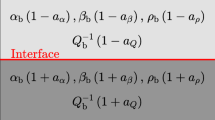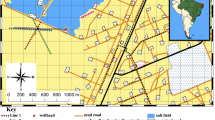Abstract
Thin and relatively thin anelastic layers (compared to the signal wavelength) generally represent hydrocarbon reservoirs, where the rock is a sandstone or a source rock saturated with brine, oil and gas. The study of the seismic response of these layers is important to detect the hydrocarbons on the basis of the reflection and transmission coefficients and the wave velocity and attenuation properties. Different seismic experiments (source-receiver configurations) can provide useful information to characterise its properties. In this work, we consider varying thicknesses and Q values of the layer and analyse the reflection and transmission coefficients. Moreover, we obtain spectrograms of surface seismic profiles and vertical and horizontal well profiles (VSP and HSP, respectively) to analyse their frequency content with offset due to variations of the attenuation properties of the layer. In addition, we compare the effects due to NMO stretching and intrinsic attenuation related to the low-frequency shadows (LFS) observed in real data after stacking, since LFS can have several causes. Ambiguity is present in this case, indicating that non-stretch NMO is required, otherwise an offset mute of the data may remove useful information regarding the intrinsic (physical) loss.













Similar content being viewed by others
References
Barnes AE (2013) The myth of low-frequency shadows, EAGE Workshop on Seismic Attenuation. doi:10.3997/2214-4609.20131834
Brekhovskikh LM (1960) Waves in layered media. Academic Press Inc
Carcione JM (2015) Wave fields in real media theory and numerical simulation of wave propagation in anisotropic, anelastic, porous and electromagnetic media, 3rd edn. Elsevier
Carcione JM, Helle H, Zhao (1998) The effects of attenuation and anisotropy on reflection amplitude versus offset. Geophysics 63:1652–1658
Carcione JM, Grünhut V, Osella A (2014) Mathematical analogies in physics. Thin-layer wave theory. Ann Geophys 57:1–10. G0186; doi:10.4401/ag-6324
Carcione JM, Picotti S (2006) P-wave seismic attenuation by slow-wave diffusion: effects of inhomogeneous rock properties. Geophysics 71:O1–O8
Castagna JP, Sun SJ, Siegfried Rw (2003) Instantaneous spectral analysis: detection of low-frequency shadows associated with hydrocarbons. Lead Edge 22(2):120–127
Del Ben A, Forte E, Geletti R, Mocnik K, Pipan M (2011) Seismic exploration of a possible gas-reservoir in the south Apulia foreland. Boll Geof Teor Appl 52:607–623
Dunkin JW, Levin FK (1973) Effects of normal moveout on a seismic pulse. Geophysics 38:635–642
Ebrom D (2004) The low-frequency gas shadow on seismic sections. Lead Edge 23(8):772
Marfurt KJ, Kirlin RL (2001) Narrow-band spectral analysis and thin-bed tuning. Geophysics 66:1274–1283
Müller T, Gurevich B, Lebedev M (2010) Seismic wave attenuation and dispersion resulting from wave-induced flow in porous rocks—a review. Geophysics 75:A147–A164
Perroud H, Tygel M (2004) Nonstretch NMO. Geophysics 69:599–607
Taylor MH, Dillon WP, Pecher IA (2000) Trapping and migration of methane associated with the gas hydrate stability zone at the Blake Ridge Diapir: new insights from seismic data. Mar Geol 164:79–89
Author information
Authors and Affiliations
Corresponding author
Appendix A: Anelasticity
Appendix A: Anelasticity
The phase velocity, attenuation factor and quality factor of a viscoelastic medium are
respectively, where here c is the complex velocity of the P-wave, ω is the angular frequency ω=2π f and “Re” and “Im” take real and imaginary parts (e.g. Carcione 2015).
We consider a constant quality factor, \(\bar Q\), obtained with a spectrum of L Zener relaxation mechanisms, whose peak locations are equispaced in logω scale (see Section 2.4.6 in Carcione (2015)). We then have to find the relaxation times τ 𝜖 l and τ σ l that gives an almost constant Q in a given frequency band centred at ω 0m = 1/τ 0m . This is the location of the mechanism situated at the middle of the band, which, for odd L, has the index m = L/2 + 1. The minimum quality factor of the L peaks is the same and is given by
Carcione (2015), where ω 0m is defined below and ω 0l = 1/τ 0l are the peak locations. Then, the relaxation times are
If f 0 is the central frequency of the source wavelet, we assume that the centre peak is located at ω 0m = 2π f 0.
Finally, the complex P-wave modulus is given by
(Carcione 2015; Eq. (2.196)), where E U = ρ v 2 is the unrelaxed, high-frequency limit modulus and v is the real-valued elastic velocity. If ω → ∞, E → E U. Taking into account that E = ρ c 2, the quality factor is given by Eq. 1.
Appendix B: Reflection and transmission coefficients
Let us denote with 1 and 2 the background medium and layer, respectively (see Fig. 2) and consider only the P-waves. The reflection and transmission coefficients of a single layer of thickness h embedded in a homogeneous medium, corresponding to an incidence wave with angle θ 1, are
Brekhovskikh (1960), Carcione et al. (2014), respectively, where
\(\mathrm {i} = \sqrt {-1}\), ω is the angular frequency, c is the complex P-wave velocity, θ 2 is the refraction angle
and Snell’s law is sinθ 1/c 1 = sinθ 2/c 2. Here, we use the convention exp(iω t) for the Fourier transform. The incident wave is homogeneous, i.e. the propagation and attenuation directions coincide (e.g. Carcione 2015).
Appendix C: Correction of the NMO stretch
Dunkin and Levin (1973) have explained the stretch effect after the NMO correction. Let us assume that at a given offset, the signal before the NMO correction is f(t). After the correction, the new (stretched) signal becomes
where a is the stretch ratio, given below. The frequency domain version of Eq. 8 is
where G and F are the Fourier transforms of f and g, respectively. The stretch ratio is
where t is the uncorrected traveltime, t 0 is the corrected traveltime, x is the offset and v s is the stacking velocity.
The correction can be performed in the frequency domain, based on Eq. 9 by restoring each frequency component ω to the right value a ω and dividing the result by a, i.e. if G is the uncorrected spectrum, we have
Here, we use the method of Perroud and Tygel (2004). The basic processes, i.e. velocity analysis, NMO and stack, are unchanged. An extra step is required to avoid the stretch effect, the adjustment of the time-velocity function obtained from the velocity analysis.
If τ represents a time-shift since the onset of the seismic pulse, the following formula gives the adjusted NMO velocity v(τ) for an event at time t(x) for offset x and NMO velocity v NMO (obtained from the velocity analysis) at zero-offset time t 0:
One can observe that v(τ) decreases when τ increases, so the NMO adjusted velocity always decreases along the seismic pulse. For relatively small τ, the decrease is quasi-linear and can therefore be described by a velocity at the beginning of the pulse, and a velocity at the end of the pulse, for the maximum τ whose value should correspond to the pulse length. We can approximate the NMO velocity by the RMS velocity, v RMS. For n layers, the traveltime is
where
v k is the seismic velocity of the k layer, τ k is the vertical two-way traveltime within layer k and \(t_{0} = {{\sum }_{1}^{n}} \tau _{i}\).
Rights and permissions
About this article
Cite this article
Qadrouh, A.N., Carcione, J.M., Salim, A.M.A. et al. Seismic spectrograms of an anelastic layer with different source-receivers configurations. Arab J Geosci 9, 413 (2016). https://doi.org/10.1007/s12517-016-2429-3
Received:
Accepted:
Published:
DOI: https://doi.org/10.1007/s12517-016-2429-3




